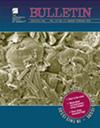Updating the Upper Cretaceous (Campanian) Two Medicine Formation of Montana: Lithostratigraphic revisions, new CA-ID-TIMS U-Pb ages, and a calibrated framework for dinosaur occurrences
IF 3.9
1区 地球科学
Q1 GEOSCIENCES, MULTIDISCIPLINARY
引用次数: 0
Abstract
The Campanian Two Medicine Formation of northwestern Montana, USA, is richly fossiliferous, and discoveries made within the unit over the past century have greatly advanced our appreciation of dinosaur paleobiology and evolution. Previously undifferentiated from a lithostratigraphic perspective, the formation is now subdivided into four new members that include (from base to top) (1) the Rock City Member, (2) the Shields Crossing Member, (3) the Hagans Crossing Member, and (4) the Flag Butte Member. These new formal units and their associated fossil occurrences are also now included in an age model founded on eight high-resolution chemical abrasion−isotope dilution−thermal ionization mass spectrometry (CA-ID-TIMS) U-Pb ages. New age data confirm that the Two Medicine Formation accumulated during much of the Campanian, with deposition spanning ca. 82.4 Ma to 74.4 Ma. New age data further indicate that a major reorganization of depositional systems, marked by a shift from predominantly lacustrine to alluvial facies and accompanied by a dramatic increase in accommodation, transpired near the base of the new Flag Butte Member at ca. 76.3 Ma. This change in depositional regime correlates in age with the Judith River−Belly River discontinuity, which marks the contact between the McClelland Ferry and Coal Ridge Members in the Judith River Formation and coincides with the onset of the Bearpaw transgression in north-central Montana. The new lithostratigraphic and chronostratigraphic framework for the Two Medicine Formation serves to contextualize and calibrate the formation’s rich dinosaur fossil record, which can now be interrogated with increased clarity and precision. These results also provide ground truth for numerical models that explore the structure of the fossil record in relation to alluvial architecture and terrestrial sequence stratigraphy.更新蒙大拿州的上白垩世(坎帕年)两药地层:岩层学修订、新的 CA-ID-TIMS U-Pb 年龄以及恐龙出现的校准框架
美国蒙大拿州西北部的钟乳期两药地层(Two Medicine Formation)化石丰富,上个世纪在该地层中的发现极大地推动了我们对恐龙古生物学和进化的认识。以前,从岩石地层学的角度来看,该地层是无差别的,现在被细分为四个新的成员,包括(从底部到顶部)(1) 岩石城成员,(2) 希尔兹交叉成员,(3) 哈根斯交叉成员和 (4) 旗形山丘成员。这些新的正规单元及其相关的化石点现在也被纳入了一个基于八个高分辨率化学磨蚀-同位素稀释-热电离质谱(CA-ID-TIMS)U-Pb 年龄的年龄模型中。新的年龄数据证实,两药地层是在坎帕尼亚期的大部分时间里堆积而成的,沉积时间跨度约为 82.4 Ma 到 74.4 Ma。新的年龄数据进一步表明,沉积系统发生了重大重组,其标志是从以湖相为主向冲积相为主的转变,并伴随着容纳性的急剧增加。76.3 Ma。沉积体系的这一变化与朱迪思河-贝利河不连续面的年龄相关,该不连续面标志着朱迪思河地层中麦克莱兰渡口岩组与煤岭岩组间的接触,与蒙大拿州中北部熊掌断代的开始时间相吻合。两药地层新的岩石地层学和年代地层学框架有助于对该地层丰富的恐龙化石记录进行背景分析和校准,现在可以更加清晰和精确地对其进行研究。这些结果还为探索化石记录的结构与冲积结构和陆地序列地层的关系的数字模型提供了基础数据。
本文章由计算机程序翻译,如有差异,请以英文原文为准。
求助全文
约1分钟内获得全文
求助全文
来源期刊

Geological Society of America Bulletin
地学-地球科学综合
CiteScore
9.30
自引率
8.20%
发文量
159
审稿时长
4-8 weeks
期刊介绍:
The GSA Bulletin is the Society''s premier scholarly journal, published continuously since 1890. Its first editor was William John (WJ) McGee, who was responsible for establishing much of its original style and format. Fully refereed, each bimonthly issue includes 16-20 papers focusing on the most definitive, timely, and classic-style research in all earth-science disciplines. The Bulletin welcomes most contributions that are data-rich, mature studies of broad interest (i.e., of interest to more than one sub-discipline of earth science) and of lasting, archival quality. These include (but are not limited to) studies related to tectonics, structural geology, geochemistry, geophysics, hydrogeology, marine geology, paleoclimatology, planetary geology, quaternary geology/geomorphology, sedimentary geology, stratigraphy, and volcanology. The journal is committed to further developing both the scope of its content and its international profile so that it publishes the most current earth science research that will be of wide interest to geoscientists.
 求助内容:
求助内容: 应助结果提醒方式:
应助结果提醒方式:


